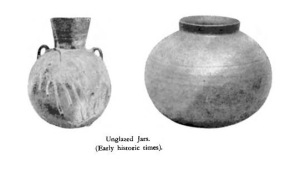The tutelar deity of well-cleaners is known by two names, Mizuha-nome-no-mikoto, the Goddess of Wells, and by the more generic Water-god, and usually male counterpart, Suijin-Sama whose role is to protect all wells and keep the water sweet and cool. The wells must be cleaned once a year, or the breaking of cleanliness law by the house-owners will incur the wrath of the deity, bringing sickness and death.
The goddess(god) rarely manifests her/himself, but when s/he does, s/he takes the form of a serpent. Her/His familiars or messengers, are usually a pair of fish called funa (crucian carp), a live pair are released into wells to eat the larvae inhabiting the well water.
According to Lafcadio Hearn’s writings, once a month, the deity is visited by a Shinto priest who repeats ancient prayers to the Well-God(dess) and plants nobori, paper flags at the edge of the well. The same ritual is also performed after the well has been cleaned.
The first water of the well must be drawn by a man, for the presumably jealous well goddess would be angered by a woman doing so.
See: “Out of the East: Reveries and Studies in Japan” by Lafcadio Hearn
According to Lafcadio Hearn, Mizuhanome/Suijin have no shrines, but interestingly, R.A.B. Ponsonby-Fane in his “Studies of Shinto and Shrines”, traces the Mizuhanome deity to one of the three Amashi-no-kami rain deities enshrined in the Nibu-kawakami jinja, located on Upper River Nibu in Yoshino-gun.
And in “Nibukawakami Jinja”, Ponsonby-Fane writes that all the authorities or sources(as well as in Studies in Shinto & Shrines, at p. 264), including the Engishiki Jimmyocho, are unanimous in identifying the deity worshipped there as Mizuhanome-no-kami deity as a rain goddess and as one who received “hei” from the court during the Tsukinami and Niiname festivals.
Ponsonby-Fane also hypothesizes that Mizuha-nome-no-mikoto (or Mizuhanome-no-kami) was one of the water deities venerated by local indigenous aboriginals when Emperor Jimmu arrived and which is why it was decided to build the Nibukawakami shrine at that very location, and thereby including the female Mizuha-nome-no-mikoto, along with the other Amashi rain deities, Takaokami and Kuraokami, the latter two being male raingods.

Emperor Jimmu is said to have sacrificed 80 dishes and jars at upper Nibu River to the Deity of Heaven and Earth
The earliest date recorded in the Engishiki for the receipt of “hei” (offerings given by the Imperial Court) by the goddess from the Imperial Court is 763 A.D. though the founding of the shrine is given as a hundred years earlier.
Kojiki and Nihonshoki record Mizuha-nome-no-mikoto as the water goddess born to Izanami-no-mikoto, from her urine. (According to Kojiki, Kuraokami and Kuramitsuha were produced from the blood as it collected on the hilt of Izanagi’s sword and dripped through his fingers.)
The fact of the worship of a water goddess called Mizuha-nome-no-mikoto is thus corroborated by the Engishiki records, as well as both the Kojiki and Nihonshoki accounts.
According to Daniel Holtom’s “National Faith of Japan“(at p. 96), earlier sources called the shrine Nibu Kawakami which means Nibu river rain-chief shrines, or simply Rain Chief shrines.
“The title translated Rain-Chief is read Okami in the original and is written with two ideograms, one meaning rain and the other chief or head. We are thus in possession of an easy key to understanding the meaning of the names of the two deities, just introduced. The gods of the Nibu shrines are Dark Rain-Chief Deity (Kura-Okami-no-Kami) and “Fierce Rain-Chief Deity” (Taka Okami-no-Kami), kura(kurai) being taken in the ordinary sense of dark and taka being taken in the sense of takeki “fierce” or “brave”. [note: kura also means “narrow gorge beneath a cliff“]
The Upper River Nibu Kawakami shrine and the Lower River Nibu Kawakami shrine’s identical documents thus reveal the true function of the two male water-gods Taka and Kura Okami. The note in the shrine text document explained that the two deities are rain dragons, the lower shrine deity being a guardian of the valley, and the upper one, a guardian dragon god of mountain tops. Both deities are considered to be one, and to be Amashi-no-kami, rain gods. A black horse was offered to the Kura Okami deity to induce the deity to produce rain during droughts, while a white horse was meant to halt the rain. See A study of rain deities and rain wizards of Japan.
On the more generic water god, the Encyclopedia of Shinto has more on Suijin-no-kami or Water god.
“Water-kami,” a general term for tutelaries of water, found in a variety of forms. Water is of crucial importance in agriculture, and the availability and quality of water can spell life or death to farmers; as a result, tutelaries of water naturally came to be associated with rice-field tutelaries (ta no kami). Most suijin are found enshrined on the dikes of irrigation canals, or alongside paddy fields. In some cases, water kami may be found enshrined as “water distributing kami” (mikumari no kami) at the mountain springs forming the sources of agricultural waterways, in which cases they may also be associated with the kami of the mountain (yama no kami). In addition to their connection with the water used in agriculture, water kami are also found enshrined at sources of water used in everyday life, such as household wells, springs, and streams…”
Further reading:
Suijin (Encyclopedia of Shinto)
Suijin (Wikipedia)
Shumacher, Mark, Suijin (A-Z Photo Dictionary)

[…] So how many layers deep are we really, and whose head is everyone rattling around in? It has to be either Narihisago’s or Hondōmachi’s. I’d guess that it’s Narihisago’s, but that Hondōmachi has some as yet unrevealed connection to the Mizuhanome. (Which is, incidentally, the name of a goddess of wells.) […]